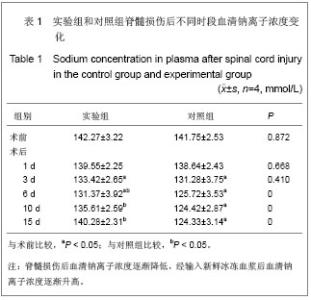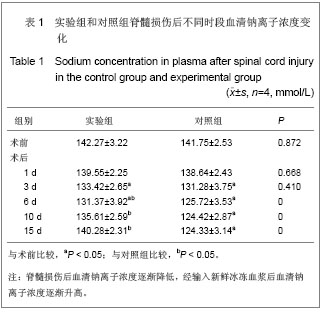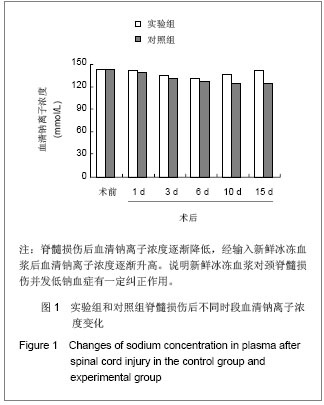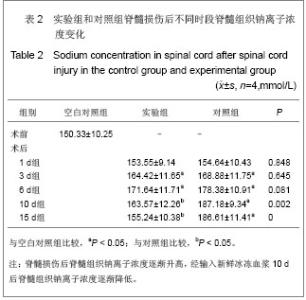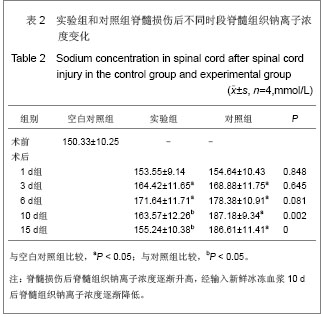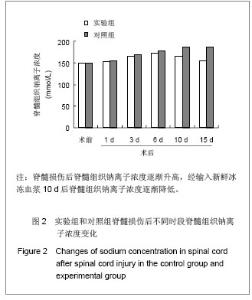Chinese Journal of Tissue Engineering Research ›› 2013, Vol. 17 ›› Issue (17): 3223-3230.doi: 10.3969/j.issn.2095-4344.2013.17.024
Fresh frozen plasma transfusion for the treatment of hyponatremia after cervical spinal cord injury
Zhang Sheng-fei, Wang Yong-xiang, Feng Xin-min, Tao Yu-ping
- Northern Jiangsu People’s Hospital, Yangzhou 225001, Jiangsu Province, China
-
Received:2012-08-04Revised:2012-11-07Online:2013-04-23Published:2013-04-23 -
About author:Zhang Sheng-fei★, Master, Northern Jiangsu People’s Hospital, Yangzhou 225001, Jiangsu Province, China dafei8251@163.com
CLC Number:
Cite this article
Zhang Sheng-fei, Wang Yong-xiang, Feng Xin-min, Tao Yu-ping. Fresh frozen plasma transfusion for the treatment of hyponatremia after cervical spinal cord injury[J]. Chinese Journal of Tissue Engineering Research, 2013, 17(17): 3223-3230.
share this article
| [1] Jang JW, Lee JK, Seo BR,et al. Traumatic lumbar intradural disc rupture associated with an adjacent spinal compression fracture.Spine (Phila Pa 1976). 2010;35(15): E726-729.[2] Wang H, Hu Y. Analysis of mechanisms and treatment of hyponatremia in acute spinal cord injuries. Zhongguo Gu Shang. 2012;25(4):306-309.[3] Kovacs L, Robertson GL.Syndrome of inappropriate antidiuresis. Endocrinol Metab Clin North Am. 1992;21(4):859-875. [4] de Souza JA, Davis DW, Zhang Y,et al.A phase II study of lapatinib in recurrent/metastatic squamous cell carcinoma of the head and neck.Clin Cancer Res. 2012;18(8):2336-2343.[5] Biyani A, Inman CG, el Masry WS. Hyponatraemia after acute spinal injury. Injury. 1993;24(10):671-673.[6] Zhang L,Cai QL,Dang GT,et al. Beijing Yike Daxue Xuebao. 2000;32(4):369-373.张立,蔡钦林,党耕町,等.Frankel-A型急性颈脊髓损伤后继发的低钠血症[J].北京医科大学学报,2000,32(4):369-373.[7] Karlsson AK, Krassioukov AV. Hyponatremia-induced transient visual disturbances in acute spinal cord injury. Spinal Cord. 2004;42(3):204-207.[8] Koide T, Wakabayashi T, Matsuda T,et al.Hyponatremia associated with paroxetine induced by sodium-restricted diet and hypotonic saline.Pharm World Sci. 2010;32(1):19-21.[9] Furlan JC, Fehlings MG. Hyponatremia in the acute stage after traumatic cervical spinal cord injury: clinical and neuroanatomic evidence for autonomic dysfunction.Spine (Phila Pa 1976). 2009;34(5):501-511.[10] Zeidel ML. Hyponatremia: mechanisms and newer treatments. Endocr Pract. 2010;16(5):882-887.[11] Lai MY, Lin CC, Chung SL, et al. Milky plasma, diabetes, and severe hyponatremia. Kidney Int. 2009;75(9):996. [12] Xu RM, Zhu YZ, Ma WH,et al.The prevention and treatment of cerebrospinal fluid leakage following cervical spine surgery. Zhongguo Gu Shang. 2010;23(1):20-22.[13] Xie M, Zhou Z, Zhou L.Endoscopic thyroidectomy with filling the neck of rabbits with carbon dioxide and saline.Lin Chuang Er Bi Yan Hou Tou Jing Wai Ke Za Zhi. 2009; 23(18):849-853.[14] Anderson PN,Fabes J,Hunt D.The role of inhibitory molecules in limitingaxonal regeneration in the mammalian spinal cord. Becker CG Becker T Editors.Model organisms in spinal cord regeneration[M].Weinheim:Wiley-VCH,2007:3-50.[15] Allen AR.Surgery of experimental lesions of spinal cord equivalent to crush injury of fracture dislocation of spinal column:A preliminary report. JAMA. 1911;11:878-80.[16] Krenz NR, Weaver LC. Changes in the morphology of sympathetic preganglionic neurons parallel the development of autonomic dysreflexia after spinal cord injury in rats. Neurosci Lett. 1998;243(1-3):61-64.[17] Simsek E, Dilli D, Yasitli U,et al.Cerebral salt wasting in a child with cervicothoracic hematoma.J Pediatr Endocrinol Metab. 2008;21(7):695-700.[18] Akhtar MM, Orakzai N, Qureshi AM.Trans urethral electric vaporisation of prostate as an alternate to trans urethral resection in benign prostatic hyperplasia.J Ayub Med Coll Abbottabad. 2004;16(4):16-20.[19] Waynforth HB,Flecknell PA.Experimental and surgical technique in the rat[M].San Diego:Academic Press,1992.[20] Galizia MS, Alves CC, Tamanaha EM, et al. A new swivel model for parenteral and enteral infusion in rats. J Surg Res. 2005;128(1):3-8.[21] Chen L,Quan ZX. Zhonghua Chuangshang Zazhi. 2004; 20(3):187-189.陈亮,权正学.颈髓损伤后的低钠血症[J].中华创伤杂志,2004, 20(3):187-189.[22] Zhang L,Dang GT,Guo SQ,et al. Beijing Yike Daxue Xuebao. 1995;27(3):191-192.张立,党耕町,郭昭庆,等.颈髓损伤与低钠血症[J].北京医科大学学报,1995,27(3):191-192.[23] Li LX,Yuan XJ,Wang R,et al. Zhongguo Gushang. 2001;14(8): 459-461.李立新,原晓景,王瑞,等.急性颈髓损伤合并抗利尿激素分泌异常综合征的影响因素[J].中国骨伤,2001,14(8):459-461.[24] Kuriki A, Ishihara K, Satoh H,et al.Syndrome of inappropriate secretion of anti-diuretic hormone associated with limbic encephalitis due to herpes simplex virus infection--a case report.Rinsho Shinkeigaku. 2008;48(3):184-190.[25] Van Waes C, Chang AA, Lebowitz PF,et al. Inhibition of nuclear factor-kappaB and target genes during combined therapy with proteasome inhibitor bortezomib and reirradiation in patients with recurrent head-and-neck squamous cell carcinoma.Int J Radiat Oncol Biol Phys. 2005; 63(5):1400-1412.[26] Gowrishankar M, Sapir D, Pace K, et al. Profound natriuresis, extracellular fluid volume contraction, and hypernatremia with hypertonic losses following trauma.Geriatr Nephrol Urol. 1997; 7(2):95-100.[27] Zhang L,Cai QL,Liu ZJ,et al. Zhongguo Wuzhenxue Zazhi. 2002;2(7):968-970.张立,蔡钦林,刘忠军,等.急性完全性颈髓损伤继发低钠血症的临床观察[J].中国误诊学杂志,2002,2(7):968-970.[28] Guerrero R, Pumar A, Soto A,et al. Early hyponatraemia after pituitary surgery: cerebral salt-wasting syndrome. Eur J Endocrinol. 2007;156(6):611-616.[29] Wijdicks EF, Vermeulen M, van Brummelen P, et al. Digoxin-like immunoreactive substance in patients with aneurysmal subarachnoid haemorrhage. Br Med J (Clin Res Ed). 1987;294(6574):729-732.[30] Damaraju SC, Rajshekhar V, Chandy MJ.Validation study of a central venous pressure-based protocol for the management of neurosurgical patients with hyponatremia and natriuresis. Neurosurgery. 1997;40(2):312-316.[31] Gray ST, Holbrook EH, Najm MH,et al.Syndrome of inappropriate antidiuretic hormone secretion in patients with olfactory neuroblastoma.Otolaryngol Head Neck Surg. 2012; 147(1):147-151.[32] Hoorn EJ, van der Lubbe N, Zietse R. SIADH and hyponatraemia: why does it matter. NDT Plus. 2009; 2 (Suppl_3):iii5-iii11.[33] Bartter FC, Schwartz WB. The syndrome of inappropriate secretion of antidiuretic hormone. Am J Med. 1967;42(5): 790-806.[34] Al Nozha OM, Vautour L, How J. Life-threatening hyponatremia following a low-iodine diet: a case report and review of all reported cases.Endocr Pract. 2011;17(5): e113-117.[35] Kageyama K, Suda T.A case of hyponatremia after cervical spinal cord injury.Endocr J. 2011;58(5):369-372.[36] Kovacs L, Robertson GL. Syndrome of inappropriate antidiuresis. Endocrinol Metab Clin North Am. 1992;21(4): 859-875.[37] Raymond DA,Maurice V. Principles of Neurology[M].New York:McGraw-Hill Company.1985:793-800.[38] Palmer BF. Hyponatremia in patients with central nervous system disease: SIADH versus CSW. Trends Endocrinol Metab. 2003;14(4):182-187.[39] Zhang L,Cai QL,Dang GT,et al. Zhonghua Chuangshang Zazhi. 2001;17(8):460-462.张立,蔡钦林,党耕町,等.急性完全性颈髓损伤患者水钠代谢紊乱及血浆心钠素的变化[J].中华创伤杂志,2001,17(8): 460-462.[40] Naka N, Takenaka S, Nanno K,et al.Acute adrenal crisis after orthopedic surgery for pathologic fracture.World J Surg Oncol. 2007;5:27.[41] Kawamata T, Harashima S, Kubo O,et al.Intrasellar remote metastasis from adenoid cystic carcinoma of parotid gland: case report.Endocr J. 2006;53(5):659-663.[42] Zhou GC,Zhao WL,Yuan KM,et al. Zhongguo Jizhu Jisui Zazhi. 1995;5(5):193-196.周国昌,赵文良,苑克明,等.急性颈髓损伤并发抗利尿激素分泌异常综合征[J].中国脊柱脊髓杂志,1995,5(5):193-196.[43] Momi J, Tang C, Abcar AC, et al. Hyponatremia in a patient with cryptococcal meningitis: syndrome of inappropriate antidiuretic hormone (SIADH) or cerebral salt wasting (CSW). J Hosp Med. 2010;5(3):193-195.[44] Tian Y, Yu KY, Wang YP,et al. Management of cerebrospinal fluid leakage following cervical spine surgery. Chin Med Sci J. 2008;23(2):121-125.[45] Hideyama T, Tanaka H, Uesaka Y,et al. Case of primary intraocular central nervous system lymphoma with high interleukin 10 level and positive cytology in cerebrospinal fluid. Rinsho Shinkeigaku. 2008;48(6):415-418.[46] Deslarzes T, Turini P, Friolet R, et al. Cerbral salt wasting syndrome versus SIADH. Rev Med Suisse. 2009;5(225): 2281-2284.[47] Frey FJ. Hyponatraemia in patients with neurosurgical disorders: SIADH or cerebral salt wasting syndrome. Ther Umsch. 2009;66(11):769-772. [48] Wang H,Hu Y. Zhongguo Gushang. 2012;25(4):306-309.王鹤,胡勇.急性颈脊髓损伤并发低钠血症的机制及治疗分析[J].中国骨伤,2012,25(4):306-309. [49] Frisbie JH. Salt wasting, hypotension, polydipsia, and hyponatremia and the level of spinal cord injury. Spinal Cord. 2007;45(8):563-568.[50] Chawla A, Sterns RH, Nigwekar SU,et al.Mortality and serum sodium: do patients die from or with hyponatremia.Clin J Am Soc Nephrol. 2011;6(5):960-965.[51] Michielsen DP, Coomans D, Braeckman JG,et al.Bipolar transurethral resection in saline: the solution to avoid hyponatraemia and transurethral resection syndrome.Scand J Urol Nephrol. 2010;44(4):228-235.[52] Peruzzi WT, Shapiro BA, Meyer PR Jr,et al. Hyponatremia in acute spinal cord injury. Crit Care Med. 1994;22(2):252-258.[53] Liu W,Ying YM,Wang J,et al. Zhonghua Guke Zazhi. 2012; 32(4): 299-303.刘伟,幸永明,王杰,等.不同程度颈脊髓损伤后低钠血症的临床分析[J].中华骨科杂志,2012,32(4): 299-303.[54] Kang J,Yuan W,Wang XW,et al. Jizhu Waike Zazhi. 2011;9(1): 27-30.康健,袁文,王新伟,等.急性颈髓损伤后低钠血症影响因素的logistic多元回归分析[J].脊柱外科杂志,2011,9(1):27-30.[55] Sun SG,Sun HH,Zhou Y,et al. Zhongguo Yishi Zazhi. 2011; 13(1):90-91.孙嗣国,孙宏慧,周勇,等.急性颈脊髓损伤后低钠血症发病机制及治疗方法的探讨[J].中国医师杂志, 2011,13(1):90-91.[56] Wu CT, Wong CS, Yeh CC,et al.Treatment of cerebral vasospasm after subarachnoid hemorrhage--a review.Acta Anaesthesiol Taiwan. 2004;42(4):215-222.[57] Nguyen MK, Rastogi A, Kurtz I. True hyponatremia secondary to intravenous immunoglobulin. Clin Exp Nephrol. 2006;10(2): 124-126. |
| [1] | Zhang Yu, Tian Shaoqi, Zeng Guobo, Hu Chuan. Risk factors for myocardial infarction following primary total joint arthroplasty [J]. Chinese Journal of Tissue Engineering Research, 2021, 25(9): 1340-1345. |
| [2] | Ji Zhixiang, Lan Changgong. Polymorphism of urate transporter in gout and its correlation with gout treatment [J]. Chinese Journal of Tissue Engineering Research, 2021, 25(8): 1290-1298. |
| [3] | Jiang Hongying, Zhu Liang, Yu Xi, Huang Jing, Xiang Xiaona, Lan Zhengyan, He Hongchen. Effect of platelet-rich plasma on pressure ulcers after spinal cord injury [J]. Chinese Journal of Tissue Engineering Research, 2021, 25(8): 1149-1153. |
| [4] | Wu Xun, Meng Juanhong, Zhang Jianyun, Wang Liang. Concentrated growth factors in the repair of a full-thickness condylar cartilage defect in a rabbit [J]. Chinese Journal of Tissue Engineering Research, 2021, 25(8): 1166-1171. |
| [5] | Tang Hui, Yao Zhihao, Luo Daowen, Peng Shuanglin, Yang Shuanglin, Wang Lang, Xiao Jingang. High fat and high sugar diet combined with streptozotocin to establish a rat model of type 2 diabetic osteoporosis [J]. Chinese Journal of Tissue Engineering Research, 2021, 25(8): 1207-1211. |
| [6] | Chai Le, Lü Jianlan, Hu Jintao, Hu Huahui, Xu Qingjun, Yu Jinwei, Quan Renfu. Signal pathway variation after induction of inflammatory response in rats with acute spinal cord injury [J]. Chinese Journal of Tissue Engineering Research, 2021, 25(8): 1218-1223. |
| [7] | Zhang Xiumei, Zhai Yunkai, Zhao Jie, Zhao Meng. Research hotspots of organoid models in recent 10 years: a search in domestic and foreign databases [J]. Chinese Journal of Tissue Engineering Research, 2021, 25(8): 1249-1255. |
| [8] | Wan Ran, Shi Xu, Liu Jingsong, Wang Yansong. Research progress in the treatment of spinal cord injury with mesenchymal stem cell secretome [J]. Chinese Journal of Tissue Engineering Research, 2021, 25(7): 1088-1095. |
| [9] | Jiao Hui, Zhang Yining, Song Yuqing, Lin Yu, Wang Xiuli. Advances in research and application of breast cancer organoids [J]. Chinese Journal of Tissue Engineering Research, 2021, 25(7): 1122-1128. |
| [10] | Kong Desheng, He Jingjing, Feng Baofeng, Guo Ruiyun, Asiamah Ernest Amponsah, Lü Fei, Zhang Shuhan, Zhang Xiaolin, Ma Jun, Cui Huixian. Efficacy of mesenchymal stem cells in the spinal cord injury of large animal models: a meta-analysis [J]. Chinese Journal of Tissue Engineering Research, 2021, 25(7): 1142-1148. |
| [11] | Yuan Xinping, Shao Yanbo, Wu Chao, Wang Jianling, Tong Liangcheng, Li Ying. Accuracy of target bone segments in personalized differential modeling and simulation of CT scanning parameters at fracture end [J]. Chinese Journal of Tissue Engineering Research, 2021, 25(6): 912-916. |
| [12] | Xie Yang, Zhang Shujiang, Liu Menglan, Luo Ying, Yang Yang, Li Zuoxiao. Mechanism by which rapamycin protects spinal cord neurons in experimental autoimmune encephalomyelitis mice [J]. Chinese Journal of Tissue Engineering Research, 2021, 25(5): 695-700. |
| [13] | Ma Binxiang, He Wanqing, Zhou Guangchao, Guan Yonglin. Triptolide improves motor dysfunction in rats following spinal cord injury [J]. Chinese Journal of Tissue Engineering Research, 2021, 25(5): 701-706. |
| [14] | Luo Xuanxiang, Jing Li, Pan Bin, Feng Hu. Effect of mecobalamine combined with mouse nerve growth factor on nerve function recovery after cervical spondylotic myelopathy surgery [J]. Chinese Journal of Tissue Engineering Research, 2021, 25(5): 719-722. |
| [15] | Zhang Mi, Wu Saixuan, Dong Ming, Lu Ying, Niu Weidong. Expression of interleukin-24 in a mouse model of periapical periodontitis [J]. Chinese Journal of Tissue Engineering Research, 2021, 25(5): 679-684. |
| Viewed | ||||||
|
Full text |
|
|||||
|
Abstract |
|
|||||
